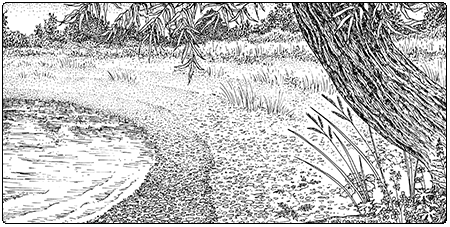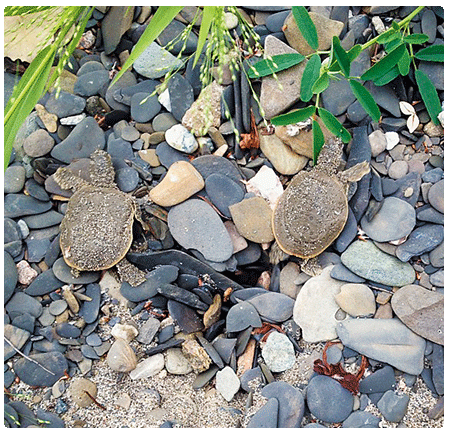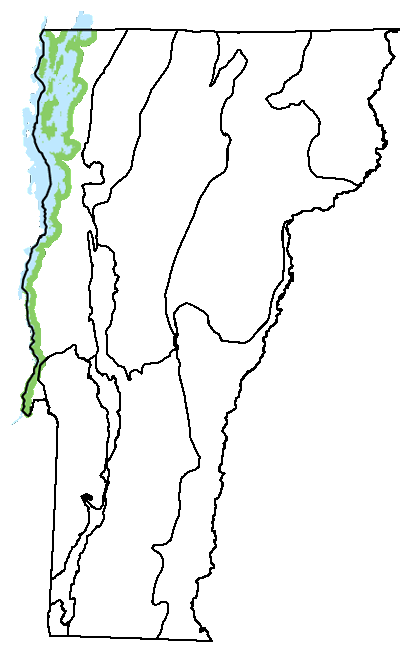Ecology and Physical Setting 
You may know these beaches as good places to find flat skipping stones. Lake Shale or Cobble Beaches occur on lakeshores where there is enough disturbance to keep the shore open and to break rock into small fragments, but where sand is lacking. The rock fragments, such as cobble (rounded fragments) or shingle (flat pieces of shale), may be formed from the breakup of rocks nearby or brought from a short distance away by water. The rocks are shifted around each year with ice and flooding, so very few perennial plants can become established. In late winter and early spring, large chunks of ice are forced up onto the beach, scraping the substrate. These ice blocks can melt slowly, further hindering the establishment of spring vegetation. In the summer, wave action creates more movement, uprooting plants that do establish. Sunlight also heats the rock, further adding to the stresses that plants must withstand and thereby limiting the number of species that can occur here.
 There is great variety in these beaches, a result of variability in the shape and size of the rocks, and in the available moisture. Shingle beaches are less stable than cobble beaches because the flat rock fragments move about more easily. You can hear the shingles shift when a wave breaks on the beach and the water flows lakeward again. These unstable beaches tend to be sparsely vegetated. On cobble beaches, soil can accumulate between the rounded, slightly more stable, rocks, so they tend to have more perennial plants.
There is great variety in these beaches, a result of variability in the shape and size of the rocks, and in the available moisture. Shingle beaches are less stable than cobble beaches because the flat rock fragments move about more easily. You can hear the shingles shift when a wave breaks on the beach and the water flows lakeward again. These unstable beaches tend to be sparsely vegetated. On cobble beaches, soil can accumulate between the rounded, slightly more stable, rocks, so they tend to have more perennial plants.
Although Lake Shale or Cobble Beaches are not wetland communities, they are often found adjacent to and interfingering with wetland communities, and they themselves have some wetland characteristics and plants. This situation is typical on many shores, where changes in moisture and substrate happen over very short distances and where communities readily intermingle.
Vegetation
Lake Shale or Cobble Beaches are very sparsely vegetated, with a mix of annual herbs, perennial herbs, a few shrubs, and often a line of trees at the upper edge of the beach. Some typical plants include Indian hemp, cocklebur, silverweed, Canada anemone, and woolly-headed willow. Green ash and cottonwood line the upper end of the beach. As in other naturally open communities, many non-native plants find this a suitable habitat, and some are abundant.
Wildlife Habitat
Spiny softshells may be the most famous animal that relies on Lake Shale or Cobble Beaches. This very rare, primarily aquatic turtle is seldom found on land, except when females climb onto beaches in late May to dig nests and lay eggs. Raccoons are one of the greatest threats to this species. They root around, dig up nests, and eat the turtle eggs. Northern map turtles are also mostly aquatic and nest on Lake Shale or Cobble Beaches of Lake Champlain. Spotted sandpipers build nests in shallow depressions excavated on the beach. These nests are hidden by logs or brush and are lined with moss and grass.

Related Communities
- Lake Sand Beach can intermingle with Lake Shale or Cobble Beach. Lake Sand Beaches develop and persist where there is a constant supply of sand brought in from distant sources, such as from the mouth of a large river.
- River Cobble Shores have similar substrates, but occur along high-gradient, flashy rivers. They are moist and are considered wetlands.
- Lakeshore Grassland is a wetland that can be very similar to Lake Shale or Cobble Beach, and the two often occur side by side. Lakeshore Grasslands occur in areas more protected from wave and ice action. Fine sediments accumulate between the cobbles, providing a stable, moist substrate during the growing season. As a result, they are more densely vegetated.
Conservation Status and Management Considerations
This community type is threatened by increasing shoreline development, but it is only the most severe alterations that will actually eliminate areas of Lake Shale or Cobble Beach. The species that occur in these communities seem well adapted to minor disturbance, including the disturbance of humans walking, wading, and launching small boats. Several examples of this community type are found on protected lands.
Distribution/Abundance
Lake Shale or Cobble Beaches are known in Vermont only from Lake Champlain, where miles of this community can be found. Similar communities are likely found throughout the region on larger lakes.
Characteristic Plants
Trees
Green ash – Fraxinus pennsylvanica
Cottonwood – Populus deltoides
Silver maple – Acer saccharinum
Freeman’s maple – Acer ×freemanii
Shrubs
Woolly-headed willow – Salix eriocephala
Shining willow – Salix lucida
Herbs
Indian hemp – Apocynum cannabinum
Cocklebur – Xanthium strumarium
Clammyweed – Polanisia dodecandra
Joe-pye weed – Eutrochium maculatum
Freshwater cordgrass – Spartina pectinata
Silverweed – Argentina anserina
Water horehound – Lycopus uniflorus
Schreber’s muhlenbergia – Muhlenbergia schreberi
Wild mint – Mentha arvensis
Hog peanut – Amphicarpaea bracteata
Showy tick-trefoil – Desmodium canadense
Canada anemone – Anemone canadensis
Fringed loosestrife – Lysimachia ciliata
Marsh hedge nettle – Stachys palustris
Marsh skullcap – Scutellaria galericulata
Common beggar’s-ticks – Bidens frondosa
American germander – Teucrium canadense
Swamp milkweed – Asclepias incarnata
Non-native Plants

Shale or Cobble Beaches.
Coltsfoot – Tussilago farfara
White sweet clover – Melilotus albus
Reed canary grass – Phalaris arundinacea
Purple loosestrife – Lythrum salicaria
Indigo bush – Amorpha fruticosa
Rare and Uncommon Plants
Canadian milk-vetch – Astragalus canadensis
Border meadow rue – Thalictrum venulosum
Sneezeweed – Helenium autumnale
Obedience – Physostegia virginiana
Marsh vetchling – Lathyrus palustris
Associated Animals
Snapping turtle – Chelydra serpentina
Painted turtle – Chrysemys picta
Spotted sandpiper – Actitis macularius
Mink – Neovison vison
Raccoon – Procyon lotor
Macropis bee – Macropis nuda
Rare and Uncommon Animals
Spiny softshell – Apalone spinifera
Northern map turtle – Graptemys geographica
Places to Visit
Alburgh Dunes State Park, Alburgh, Vermont Department of Forests, Parks, and Recreation (VDFPR)
Knight Point State Park, North Hero, VDFPR
Round Pond State Park, South Hero, VDFPR
Kingsland Bay State Park, Ferrisburgh, VDFPR
